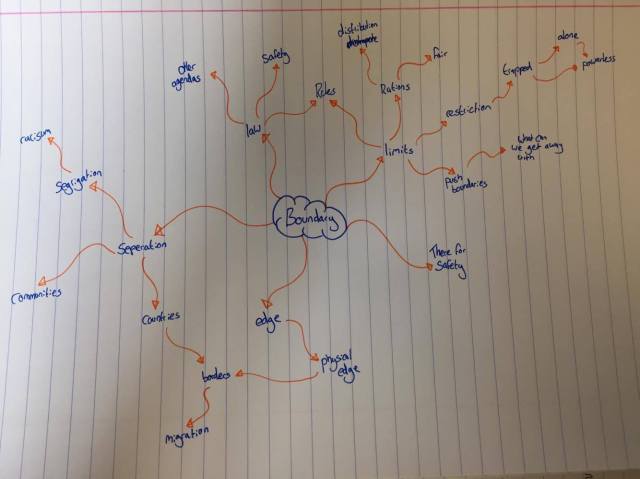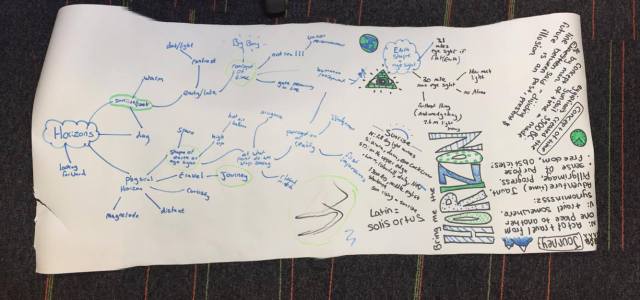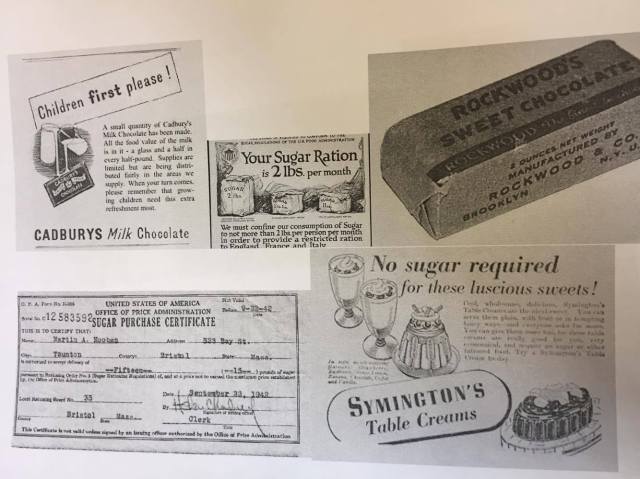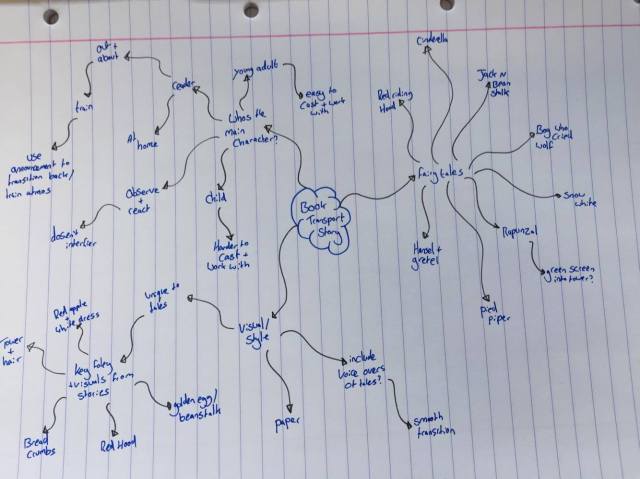Summary of the brief:
This project requires me to produce a 2-4 minute film relating to one of the given themes,
Attachment
Flow
Identity
Horizon
I can interpret these themes however I feel appropriate but must document my entire process through pre-production, production and post-production; evaluating each aspect of my work as I progress.
Key areas of this process will include: idea generation, idea development, research and development, screen/shot tests, feedback, pre-production documents, planning, evaluations, rough cuts and a presentation.
14/3/17
Are all humans able to come up with ideas or is it something we can/need to learn?
I think that everybody has the capacity to generate ideas but like everything it becomes easier and quicker with practice. The brain needs to be exercised like any other muscle and will become stronger as you do. Fundamentally I think that people form ideas based on their experiences, places they’ve been, people they’ve met; our whole lives are a bank of information from which to draw from.
What stops you or gets in the way when you are coming up with ideas?
There are a number of things that I am either guilty of or distract me to prevent idea generation. Lack of confidence in an idea is an issue, if I have doubts about an idea it is very easy to sack it off and start trying to think of different ones instead of giving it the chance to develop and see where it goes. Also lack of motivation can be difficult as I think I worry so much about how an idea will turn out and how I’m going to do it that I just won’t start from fear of failure. Pressure is another one for me. When I’m required to sit down and come up with ideas in a designated time I find it difficult as my mind will immediately go blank. Like if someone asks you what music you listen too you instantly forget everything you’ve ever heard. I guess I’m just not comfortable being put on the spot.
What can we do to help ourselves come up with ideas?
Having time to chill out and let your mind run blank is very important to me. I’m guilty of over thinking things or rushing, for example I’ll always be thinking about whats happening later, how I’m going to do it, that guy that gave me a funny look on the bus. It all adds up and clouds my mind until the point that I’m mentally tripping myself up. What helps with this though is being able to take the time to sit and do nothing and forget about the outside world, then I can look at things with a fairly fresh mindset.
Music is another really useful tool for me but a specific kind. While I’m working or trying to think about stuff I can’t listen to anything with lyrics in as I start to focus to my on that rather than what I’m actually trying to think about. I personally find that Instrumental music, especially film scores, really help me to zone out and focus on what I’m doing. I guess in general I work better when I’m able to shut myself off from whats going on around me and get into my own little world.
Tools For Idea Generation
In class we started to look at and explore some possible methods for idea generation to help us with this years FMP.

We talked about traditional techniques such as mind mapping, Brain Storming, Themes and Journalistic Questions as well as ones we hadn’t really considered such as going for a walk, finding a secluded space or yoga.
Some of these techniques that I believe may work for me include:
Mind Mapping – This involves creating a visual representation of the links between themes. I find this valuable as it allows me to get any ideas I have down easily in a way that I can start to look at it as a whole and consider how the ideas link into one another.
Visual Stimulus – This is a technique similar to mood boards. Compiling a collection of images that represent a theme, I find really helpful when generating ideas. It allows me to consider different themes subjectively and derive inspiration from them.
Music – This is a really big one for me. Listening to music allows me to almost zone out from the outside world and focus on whats in my head, I find music helpful when working or doing idea generation because of this. It has to be a specific kind of music however, instrumental music particularly film scores I find to be the best as they are very emotional pieces of music and don’t have lyrics which often distract me.
Make Some Space – This isn’t something I’d really considered as it feels like the opposite of working. Taking time out from life to go for a walk, run or find a tranquil spot allows you to distance yourself from day to day distractions and get back in touch with yourself. We were given time to do something like this in college where we could simply go for a walk alone and think about stuff. I quite enjoyed this approach and think that it is something I will try and keep doing from now on.
Talking it Through – This is something that I generally find helpful in various aspects of life although I am not always the best at initiating it. Being able to talk through your ideas I think can be really valuable as it questions how much you actually understand about it if you’re having to explain something but can also raise new questions that you might not have considered.
Journalistic Questions – I didn’t think that I would find this method that beneficial but was surprised to find out it worked reasonably well. This technique involves asking: How? What? When? Why? Who? in order to help provoke a response to a particular theme or idea.
15/3/17
Free Writing
Horizons immediently sparks ideas about moving forward and reaching towards a goal. While I was on Dom’s nature walk I found it much easier and relaxing without knowing where I was going. I was able to just walk and look as I wasn’t thinking about how to get somewhere I was focusing on the now. I started to look for links in nature that I could relate to life. I saw how the branches of trees scrapped the waters surface and held onto any debree, as though they were cleaning up the river and I thought about how nature can work together to live but people can’t Trees are stood in a moment their whole life and see change everyday. The fact that I could see through the waters surface to the bottom reminded me how everyone is hiding something underneath.
Importance of Imagination
Being able to quickly and effectively generate ideas within film making is crucial because of this it is extremely important to exercise your imagination. This can be done in a variety of ways first of which being idea generation. Sitting down with a list of word prompts or briefs is an excellent way to begin generating and developing ideas. Personally I also find that reading is another useful ‘exercise’ as it requires you to picture scenes and particular ‘shots’ as you digest the story.
I think that imagination is key to being able to enjoy your work as without it you would never have fresh ideas to work with and drive inspiration from, keeping you motivated and invested in what you do.
16/3/17
Word Prompt – Brief
The word that I choose from the brief to act as a stimulus for idea generation was ‘Horizons’ and so began using a number of techniques to start the process.
Horizons – The line at which the earth’s surface and the sky appear to meet.
Mind Maps

I found this technique very useful in exploring the relationship between themes and how I can expand on them. I like the idea of incorporating ‘boundaries’ and ‘freedom’ into my film and want to explore these themes further.

I decided to create another mind Map in order to explore the theme of boundaries this led me onto various other themes as well as limits and rations which sparked an idea around a story my Grandpa had written to do with sweet rationing.

Visual stimulus
Before I started and during mind mapping I compiled a selection of images to do with the theme Horizon in order to help prompt me for ideas and themes. When looking at images such as these I like to imagine how I would feel in that place and that process I find helpful when generating ideas.

My mind map lead me onto the idea of freedom and while I was thinking about that theme I came across this image. It stood out to me because I think it represented the idea of being blocked from your freedom or from moving forward, a theme which came while I was exploring ‘Horizons’
Idea 1 – Grandpa’s Story
One possible idea I’ve had for my FMP is an adaptation of a story my Grandpa wrote. While I was exploring aspects of the theme ‘Horizons’ I came across the motion of moving forward or progressing from hard times into something new. This got me thinking about a fictional story by my Grandpa which follows a Magic Intelligence agent (MI7) as he investigates the use of illegal magic during the 1943 Sweet rationing.
A Mr Goblin is a bumbling magician accused of producing extra sweets for children through the use of illegal magic. He then distributes these sweets over the mountain CatBells for local children.
Basically this is how he convinced me and my sister to go walking as young children.
Arthur Beasley is an MI7 agent who investigates this accusation.
If I follow this idea however some aspects of the story will have to be simplified in order to fit the brief of 2-4 min. I started by highlighting parts of the story that I felt were significant and began to produce a mind map and mood board in order to get a little more inspiration for the idea as well as get a feel for it.
Grandpa’s Story

Mind Map – Sweet Ration Story

Mood Boards – Sweet Ration Story



These will help me to visualise aspects of the story and hopefully make more informed decisions about how to go about it.
21/3/17
Idea 2 – Transported into book
This particular idea was inspired by some of my mind maps I had created for ‘Horizons’. I came across the theme of ‘perspectives’ and how people view the world differently, I thought that I could use the idea of traditional stories/fairy tales to explore this and that books can represent the boundary or horizon between imagination and reality.
This idea would involve my main character being transported into this world and witnessing these stories unfold from a far. I would focus on key moments from the stories and show them in a combination of out of focus/wide shots. For example with ‘Little red Riding hood’ I would focus on the visuals of the red dress and forrest while possibly going for a more sinister feel and heavily use sound to create the atmosphere and link in the wolf from the story. With this kind of structure I could take my character through various locations and stories with the chance to explore different styles and meanings within each one.
I feel that this is an idea that I could get really invested in and gives me a plenty of room to experiment a bit and try a combination of styles. I also feel that it fits the brief well, in terms of ‘Horizons’ I will be exploring how things are perceived as well as the boundary between real and make believe. Also this is an idea that I think would work with the 2-4 min brief giving me just enough time to develop the story without it becoming monotonous.
Mind Map – Book Transport Story

Mood Boards –
Idea 3 – Little Miss Muffet
This idea came from thinking about the themes of ‘boundaries’ and being on a ‘mental edge’. I had an idea a while ago for a simple film following the nursery rhyme Little Miss Muffet. I thought this would be a good one to concentrate on my cinematography and shot types to tell the story as there isn’t a lot of content. Once I started exploring the brief however and arrived at the theme of edge or how someone can be on a mental edge, I thought I could use this idea to explore that theme. The spider I thought could perhaps be the embodiment of her fear and anxiety and I could even explore the idea of PTSD and possibly present this story as a sort of flash back to a traumatic event.
This idea would be heavily focused on character development and I would have to find a way of making her relatable and understood. From the brief ‘Horizons’ I landed on the theme of looking forward or moving onto something better. This story could be a way of showing that progression while also touching on the idea that you never really leave your past behind you, as it shapes who you are.

Why do we tell stories?
- Document Life
- connect with people
- create an emotion
- validation
- share experiences
- pass on information
- send a message
- to remind us
In class we talked about how stories need to have some kind of emotional arc or resolution, this may be in the form of, Beginning middle and end. This means that you are taking your audience on a journey as a story develops until you arrive some where different but that stills relates to the beginning.
Im not completely convinced but I also that that there may be some benefit in cutting a story arc short. Say if your story is following a very contemporary structure and your audience is expecting the hero to get the girl and live happily ever after; is there not some value in falling short of this and not resolving the story? Almost snapping people back to reality. I do think however that the most successful or understood stories follow an emotional arc and allow their audience to feel some kind of closure.
An emotional arc is different to the structure of the film. You could for example only show the ending of a story while still having a complete emotional arc within your film. I think the easiest way for me to understand this is to say the beginning, middle and end format is used to structure your story into chronological events; where as an emotional arc is the structure of the audiences experience.
28/3/17
Shapes exercise – Thinking Visually
This is a simple exercise we did in college in order to help us think about how we can document our progression visually. This particular exercise is closely related to how we can provide evidence of our shot choices for a certain setting or object.
We had to choose a shape/object with which to show the progression of our shot choices:
Arch window –
Fire Alarm –
Drain Pipe –















































































This is already shaping up to be a great post Mathew, well done. You are taking your time and following interesting themes and concepts. I’m also really pleased to see that some of the strategies we talked about for finding head space have worked.
There are some brilliant idea coming through already and this exploratory part of the FMP is looking really strong. Now it’s time to move towards settling on a couple of ideas to take forward. Well done.
LikeLike